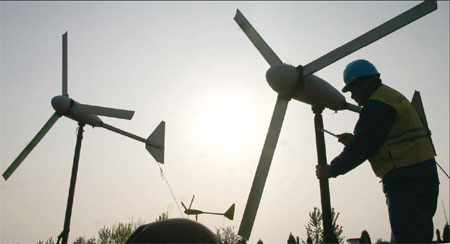Reaping wind power joins energy rotation
|
China is the fourth-largest producer of wind power after the US, Germany and Spain. The annual growth rate in wind power in China will be about 20 percent. Bian Bo |
To help the country shift toward a path of reduced carbon emissions, China's top legislature is planning to amend a law to remove a bottleneck in the development of renewable energy projects.
A draft amendment to the renewable energy law was submitted for first reading to the Standing Committee of the National People's Congress (NPC) in late August.
Many manufacturers believe that development of the country's power grid is falling behind in the area of renewable energy, creating a major stumbling block to reaching the country's goals for energy efficiency and a greener world.
For instance, areas ripe for the tapping of wind power are mainly in the remote northwest, northeast and southeast, where the power grid is poorly constructed.
Meanwhile, the scale of renewable energy projects is overexpanding despite inadequate infrastructure to collect and transmit the electricity.
The current renewable energy law orders the operators of power grids to purchase resources from registered renewable energy producers within their domains. But some grid companies fail to abide by the law, arguing that the instability of electricity from renewable energy sources is harmful to the power grid.
The draft legislation focuses on helping renewable-energy producers while ensuring the network safety of the power grid companies. It also aims to foster technological breakthroughs.
"The more renewable energy sources join the grid the more secure will the network be," said Jiang Kejun, a researcher at the Energy Research Institute, which is under the National Development and Reform Commission.
"Abundant power supplies from renewable energy sources will help the grid keep a balance between production and consumption," Jiang said.
China has set a target of having 40 percent of the country's energy coming from renewable energy by 2050.
"Renewable energy will become the mainstream power supply in 2050 from a supplementary role in 2010," said Wang Jun, director of the National Energy Administration's renewable energy department.
He envisions a future with heating dependent on solar and geothermal power, cars driven using biofuels and families owning their own photovoltaic power stations, turning the country from one of the world's biggest emitters of greenhouse gases to one of its smallest.
The 2050 target comes as it emerges that China will have 100 gigawatts of wind power capacity by 2020, more than three times the 30 gW the government set as a target 18 months ago.
The Global Wind Energy Council (GWEC) also announced China will become the biggest growth market for wind power generating capacity this year, ahead of the United States.
China is the fourth-largest producer of wind power after the US, Germany and Spain. The annual growth rate in wind power in China will be about 20 percent, Fang Junshi, head of the coal department of the National Energy Administration, said during an energy conference in Beijing.
China has about 12 gW of wind power capacity and has said it wants to raise that to about 20 gW by next year.
That means wind is set to be a bigger source of power than nuclear, despite a construction boom in nuclear power plants.
It would also be far bigger than solar power, which is expected to supply 1.8 gW of power by 2020, according to a 2007 plan.
More than 27 gW of wind power generating plants worth about $53 billion were built around the world last year.
Demand for power in China has been spurred by economic stimulus measures.
China's local wind turbine manufacturing industry has grown dramatically as a response.
Local manufacturers, dominated by Sinovel Wind Co, Xinjiang Goldwind Science & Technology Co and Dongfang Electric Corp, took about 65 percent of market share in 2008, said Shi Pengfei, vice-president of the China Wind Energy Association.
The growth in Chinese wind turbine manufacturing means China-made equipment is poised to emerge as a major force in the international wind market, although until now, Chinese suppliers have only won smaller contracts in the US, Cuba, Peru, Africa and the Middle East.
The World Wind Energy Report 2008 predicts that Asia, following China's lead, will "become the worldwide locomotive for the wind industry" and "Chinese wind turbine manufacturers will be among the top international suppliers".
However, some energy experts are worried that too much attention and aid is being paid to the renewable energy industry.
They argue China should focus on clean coal technology.
"Renewable energy is our destiny, but it is not the solution to China's urgent problem of large-scale coal burning," said Feng Xiaoting, director of the Jiangsu Coal Chemical Engineering Institute.
He said he believes that in the next 30 to 40 years, traditional energy, especially coal, will still be the powerhouse for China's growth. He said clean coal technology research and development should be a priority.
(China Daily 09/10/2009 page39)









